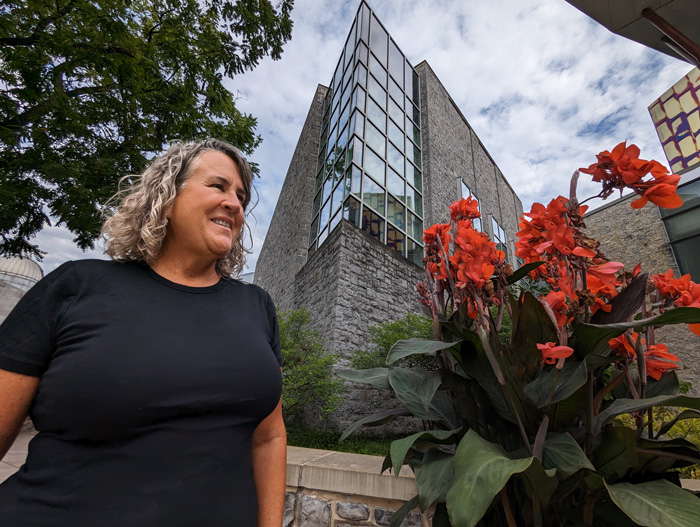Who Doesn't Love a Good Origin Story?

Kirsten Guss, outside the Rector Science Complex, home of the Department of Biology. Photo by Tony Moore.
Office Hours: Kirsten Guss, Associate Professor of Biology and John R. & Inge Paul Stafford Chair in Bioinformatics
by Tony Moore
Associate Professor of Biology Kirsten Guss is Dickinson’s John R. & Inge Paul Stafford Chair in Bioinformatics. She earned her Ph.D. from Carnegie Mellon University and teaches courses such as Genetics, Animal Development and Developmental Genomics. She studies the molecular basis of development, often focusing her research on the common fruit fly.
Like most people, I’m something of an expert in bioinformatics and the baroque intricacies of genetics. But what would you say to a high school student about why Dickinson is the place to study these topics to get a good grasp?
Choosing Dickinson is like eating at a good restaurant: you may have a favorite dish, but you have confidence that you will enjoy anything that comes out of the kitchen. How this simile relates to biology here is that we have maintained access to both the breadth and depth of the field. With respect to breadth, students can focus on anything from genes to trees, DNA to dens, as part of their major. Regarding depth, students interested in bioinformatics and genetics can work with a number of faculty who use these approaches in their teaching and research.
So your research focuses on the role of the transcription factor scalloped during development of Drosophila melanogaster. That sounds like dinosaur stuff for sure, but it’s probably not. Can you explain your research and what drives your interest in it?
I like to know how things start, and my interest in "origin stories" has led to my love of developmental biology—that and its aesthetic beauty. Transcription is an early event in gene expression, the process by which gene products are made. Gene products allow cells to do their work of making more of themselves, communicating with each other, sticking together, organizing their actions. The fruit fly has amazing tools and features that make it a great model system in which to investigate gene expression during development. I use my study of scalloped, a protein that participates in transcription, as a passport to visit the cell populations in which it may function in the fly.
That’s the long answer. What I tell people on the chairlift when I ski in Colorado is, I like DNA, microscopes and embryos of all kinds.
“Bioinformatics” has a futuristic feel, like the Tyrell Corporation or Cyberdyne would use it to either build androids or send them back through time to steal leather jackets and motorcycles from bikers. Is it in fact a future-forward discipline, and how so, if so?
Bioinformatics is broadly defined as the use of computational tools to investigate biological information. The Staffords, who established the endowed chair and student scholarship in bioinformatics over two decades ago, were forward thinking. Early in my time here, I kept a list of organismal genomes that had been sequenced. In about 2005, I gave up—wonderfully, there were far too many to track. Today, biological information is easily accessible, and plentiful. Yet, it remains critical to be able to discern meaning within the information. So I would characterize bioinformatics as both current and future-forward, in use yet innovating every day.
TAKE THE NEXT STEPS
Published December 26, 2023